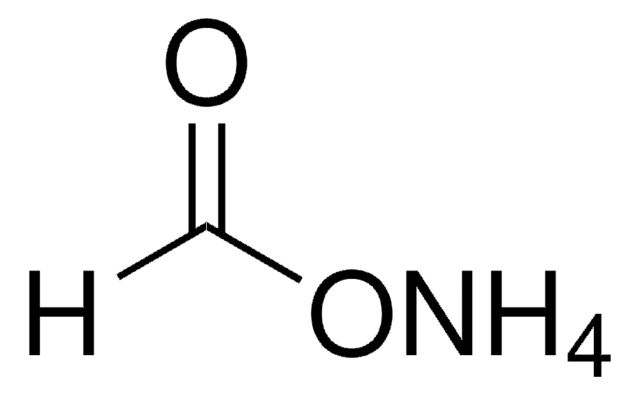33015
Acide formique
puriss. p.a., ACS reagent, reag. Ph. Eur., ≥98%
About This Item
Produits recommandés
Qualité
ACS reagent
puriss. p.a.
Niveau de qualité
Agence
reag. Ph. Eur.
suitable for EPA 1633
Densité de vapeur
1.6 (vs air)
Pression de vapeur
44.8 mmHg ( 20 °C)
Essai
≥98%
Forme
liquid
Température d'inflammation spontanée
1004 °F
Limite d'explosivité
57 %
Technique(s)
mass spectrometry (MS): suitable
Impuretés
≤0.001% ammonium (NH4)
≤0.001% non-volatile matter
≤0.005% acetic acid (CH3COOH)
Indice de réfraction
n20/D 1.370 (lit.)
pH
2.2 (20 °C, 2.2 g/L)
pb
100-101 °C (lit.)
Pf
8.2-8.4 °C (lit.)
Densité
1.22 g/mL at 25 °C (lit.)
Traces d'anions
chloride (Cl-): ≤5 mg/kg
oxalate (C2O42-): ≤50 mg/kg
sulfate (SO42-): ≤5 mg/kg
sulfite (SO32-): ≤10 mg/kg
Traces de cations
Ag: ≤0.02 mg/kg
Al: ≤0.05 mg/kg
Ba: ≤0.05 mg/kg
Be: ≤0.02 mg/kg
Bi: ≤0.1 mg/kg
Ca: ≤0.2 mg/kg
Cd: ≤0.05 mg/kg
Co: ≤0.02 mg/kg
Cr: ≤0.05 mg/kg
Cu: ≤0.02 mg/kg
Fe: ≤2 mg/kg
Ge: ≤0.05 mg/kg
K: ≤0.1 mg/kg
Li: ≤0.02 mg/kg
Mg: ≤0.5 mg/kg
Mn: ≤0.05 mg/kg
Mo: ≤0.02 mg/kg
Na: ≤0.5 mg/kg
Ni: ≤0.05 mg/kg
Pb: ≤0.02 mg/kg
Sr: ≤0.02 mg/kg
Ti: ≤0.1 mg/kg
Tl: ≤0.05 mg/kg
V: ≤0.05 mg/kg
Zn: ≤0.05 mg/kg
Zr: ≤0.1 mg/kg
Chaîne SMILES
OC=O
InChI
1S/CH2O2/c2-1-3/h1H,(H,2,3)
Clé InChI
BDAGIHXWWSANSR-UHFFFAOYSA-N
Vous recherchez des produits similaires ? Visite Guide de comparaison des produits
Catégories apparentées
Description générale
Application
Autres remarques
The article number 33015-4X2.5L-M will be discontinued. Please order the single bottle 33015-2.5L-M which is physically identical with the same exact specifications.
The article number 33015-6X1L-M will be discontinued. Please order the single bottle 33015-1L-M which is physically identical with the same exact specifications.
Informations légales
Mention d'avertissement
Danger
Mentions de danger
Classification des risques
Acute Tox. 3 Inhalation - Acute Tox. 4 Oral - Eye Dam. 1 - Flam. Liq. 3 - Skin Corr. 1A
Risques supp
Code de la classe de stockage
3 - Flammable liquids
Classe de danger pour l'eau (WGK)
WGK 1
Point d'éclair (°F)
121.1 °F - closed cup
Point d'éclair (°C)
49.5 °C - closed cup
Faites votre choix parmi les versions les plus récentes :
Déjà en possession de ce produit ?
Retrouvez la documentation relative aux produits que vous avez récemment achetés dans la Bibliothèque de documents.
Les clients ont également consulté
Notre équipe de scientifiques dispose d'une expérience dans tous les secteurs de la recherche, notamment en sciences de la vie, science des matériaux, synthèse chimique, chromatographie, analyse et dans de nombreux autres domaines..
Contacter notre Service technique





